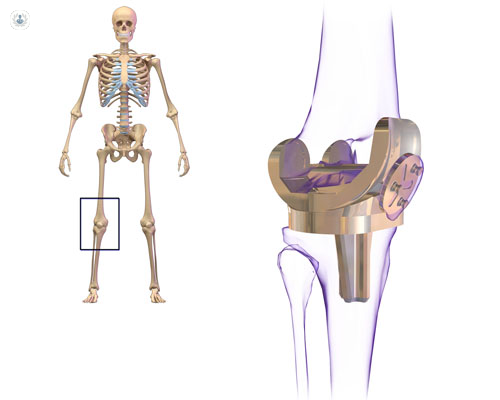Find out all about partial knee replacement surgery in this article below, as esteemed consultant orthopaedic surgeon, Mr Ravindran Kuzhupily Ranjith, provides us with an all-you-need-to-know guide about the procedure.

What is meant by a partial knee replacement?
A partial knee replacement, also known as unicompartmental knee arthroplasty, is a surgical procedure designed to relieve pain and restore function in patients with arthritis confined to a specific part of the knee. Unlike total knee replacement, which involves replacing all three compartments of the knee joint, a partial knee replacement only targets the damaged compartment—either the medial (inner), lateral (outer), or patellofemoral (front) part of the knee. This procedure is less invasive and aims to preserve as much of the natural knee structure as possible, including the healthy bone, cartilage, and ligaments.
Who is a partial knee replacement recommended for?
Partial knee replacement is typically recommended for patients with osteoarthritis that is localized to a single knee compartment and who have not found sufficient relief from conservative treatments such as medication, physical therapy, or corticosteroid injections. Candidates for this surgery usually experience significant knee pain during activities such as walking, climbing stairs, or standing up from a seated position but have a relatively intact range of motion and ligament stability. The benefits of partial knee replacement include a smaller incision, reduced recovery time, less postoperative pain, and a more natural-feeling knee compared to total knee replacement.
How is it performed, and what's recovery like?
The surgery involves removing the damaged bone and cartilage from the affected compartment and replacing it with a metal and plastic implant. This implant allows for smooth movement of the knee joint, reducing pain and improving function.
Recovery from a partial knee replacement is generally faster than from a total knee replacement, with many patients walking with assistance within a day or two after surgery and resuming normal activities within several weeks. However, it's essential to follow a rehabilitation program to strengthen the knee and improve flexibility. While partial knee replacement can provide excellent outcomes for the right candidates, it is important to consult with an orthopaedic surgeon to determine the most appropriate treatment based on the patient's condition and lifestyle.



